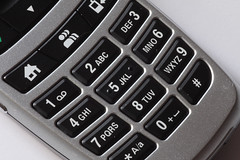
Cell phone use while driving: Should it be legal?
Originally uploaded by kmichaels97
"This essay was an assignment for a Composition class I took which required me to pick a side on a controversial topic and defend it. My true oppinion is that we should have laws prohibiting the use of cell phones while driving. Here is my argument for the other side."
With constant technological advances and the increased need to be mobile, cell phone use while driving should be not become yet another citation. An attempt to legally prohibit this type of driver distraction infringes on the personal rights of motorists. Being on the other end of a cell phone traffic ticket may negatively reflect on your driver record and can increase your insurance premiums. This law is just not enforceable. How will officials know if the driver is texting or changing a song on an MP3 player? Holding a conversation on a cell phone while driving is no more distracting than being engaged with a passenger or rowdy kids in the back seat, eating fast food or messing around with the radio.
Motorists know that using a cell phone while driving is distracting and therefore one should not do it. Do we have to place a law on all "unacceptable" behaviors? Currently text messaging is banned for all drivers in 26 states and the District of Columbia. In addition, novice drivers are banned from texting in 8 states (Alabama, Delaware, Indiana, Maine, Mississippi, Missouri, Texas, and West Virginia) and school bus drivers are banned from text messaging in Oklahoma and Texas (Insurance Institute for Highway Safety [IIHS], 2010). California, one of the states which currently have laws in place prohibiting texting and the use of hand held devices while driving, is even debating extending the violation to people riding bicycles (Miranda, 2010). How far can we allow the government to legislate our lives?
In Wisconsin, the fine for a first time so-called “Moving violation” offense is from $20 to $400 and four points on the diving record of the offender. Second time offenders will face a fine from $200 to $800 (State of Wisconsin, 2009). A single ticket will most likely not cause your car insurance rate to go up but since it is classified as a “moving violation”, multiple violations could increase your insurance premiums. In California, this type of violation is punishable by a base fine of $20 for a first offense and $50 for each subsequent offense (State of California, 2008). Each state has its own penalty and certain restrictions.
Have these state by state laws truly helped? In some cases yes, but when reporter Nannette Miranda from ABC investigated the cell phone prohibition law implemented in the state of California back in 2008, she found that “Collision claims in California were no different than in surrounding states that don't have the hands-free mandate” (Miranda, 2010). Currently, California State senator Joe Simitian is proposing to triple the current fine in an attempt to further dissuade drivers from using their cell phones while driving. He also proposes increasing the magnitude of the offense, making it a moving violation that adds points to a person's driving record (Miranda, 2010). The law is not effective because it’s not identifying the true problem; anything that is distracting to the driver could have the same effect as using a cell phone.
The GPS that sits on my dashboard and displays beautiful 3D renderings of my virtual surroundings isn’t distracting? The state of Wisconsin says they’re okay to use (State of Wisconsin, 2009). Checking your iPhone behind the wheel can get you fined across half of the country, but many states are more than happy to tweet you with up-to-the-minute directions on how to steer clear of a traffic jam. At least 22 states that ban texting while driving offer some type of service that allows motorists to get information about traffic tie-ups, road conditions or emergencies via Twitter (DeMillo, 2009).
Technology will soon minimize distracting methods of communication while driving as they are identified. In fact, there is an iPhone application available now called “Text’n Drive” which allows you to listen to your text and email messages and reply with your voice. Technologies will yet again, make these laws obsolete and another device will then take the cell phone’s place as the main distraction while driving.
Works Cited
Insurance Institute for Highway Safety, Highway Loss Data Institute. (2010, May). Cellphone Laws. Retrieved from http://www.iihs.org/laws/cellphonelaws.aspx
Miranda, N. (2010, January 29). Calif cell phone law not reducing car accidents. Retrieved from ABC 7 News, Los Angeles, CA website: http://abclocal.go.com/kabc/story?section=news/state&id=7247321
State of Wisconsin 2009-2010 Legislature. (2009). 2009 Assembly Bill 496. (2009, October 15). State of Wisconsin: Author. Retrieved from http://www.legis.state.wi.us/2009/data/AB-496.pdf
State of California, Department of Motorized Vehicles. (2008). Hand-Held Wireless Telephone: Prohibited Use. (2008, July). State of California DMV: Author. Retrieved from http://www.dmv.ca.gov/pubs/vctop/d11/vc23123.htm
DeMillo, A. (2009, Sept 20). Mixed Messages on Texting and Driving. Retrieved from Associated Press and ABC News website: http://abcnews.go.com/US/wireStory?id=8614972